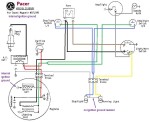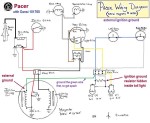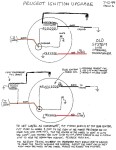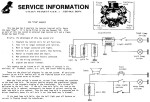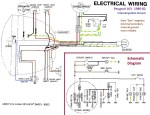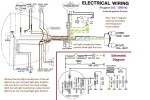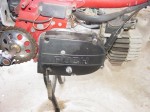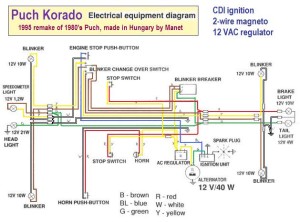Pacer Wiring: Pacer is an Italian moped with either a Morini MO1, MO2, or M1 engine. Early models with frame number 15499 and below, all have the Dansi 101286 3-wire 3-coil magneto, with the ignition source coil grounded internally. Later models with frame number 15500 and above can have either 101286 or the Dansi 101765 3-wire 2-coil magneto. The only way to tell is by the number stamped on the flywheel. The brake light switches, wiring harness, and tail light are different for each magneto type. See also Morini Wiring.
Peugeot Wiring: Peugeot was one of 3 or 4 moped makers that made their own magneto. The French maker chose to be different and make their flywheel have puller threads M20x1.0, instead of the Germans M22x1.5 or Italians M19x1.0. Pre-1980 Peugeots have an external ignition ground running the brake light. Remove the tail light assembly or unplug the wires and it won’t run. Ground the black wire under the engine by attaching it somewhere to ground (such as the tail of the decomp cable wire), to get spark, when there is no spark. 1980 and later Peugeots do not have that problem, because they have an internal ignition ground. Their ignition does not rely on any of the lights.
Peugeot Ignition Upgrade: Way back in the mid 1980’s, Peugeot 103 mopeds, 1976-1979 began to burn up condensers and points rapidly. Some of the coils would send voltage spikes. In the late 1980’s the supply of coils and stators had pretty much been used up. By 1990, even brand new Peugeot coils would not work good for long. They were going bad just sitting on the shelf. Out of desperation Shaun found a substitute inner source coil, from a Puch. It fits the Peugeot coil bolts, if they are bent in a little. A Puch outer coil (transformer) was added onto the right frame near the carburetor. ’78-79 and some ’77 103’s already have the external coil mount. 1977-earlier has to be welded on. There is a whole chapter about that here.

Peugeot 103 1976-79
103 LS, 103 LVS, 103 SP
3-wire + spark magneto
internal transformer with
external ignition ground
These 1980 and later Peugeot models already have the upgraded ignition, with external transformer coil.
Piaggio Wiring: Vespa is one brand of the parent company Piaggio. For 1970’s Vespa mopeds, there many wiring diagrams with photos and service info, located in a separate Service section, under Vespa Electrical https://www.myronsmopeds.com/category/vespa-electrical/
Puch Wiring: All 1978-1986 Puch mopeds, USA models, have a 6-wire Bosch magneto, with points, and with an external ignition ground that powers the horn. Unplugging one of the horn wires, then pressing the horn button stops the engine. In addition to that, loosen the horn/light switch clamp from the handlebar, and a brand new Puch will not run, because of disconnected horn wires. Really! Puch is the only maker that chose to meet the USA standards that way. Almost everyone else chose to power the brake light with the ignition ground. Maybe the others figured if you’re already using the brakes and your engine dies, it’s not as bad.
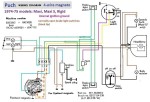
Puch 1974-75 (4-wire)
Maxi, Maxi-S, Rigid (GN)
Maxi 8353263-8421028
Rigid 6539521-6547172
4-wire Bosch magneto
1-speed 0212 124 038
internal ignition ground
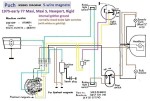
Puch 1976-77 (5-wire)
Maxi-N, Maxi-S, Nostalgic
Maxi 8421029-8709891
Rigid 6547173-6830115
5-wire Bosch magneto
1-speed 0212 124 042
internal ignition ground
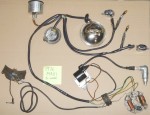
Puch 1976-77 (5-wire)
Maxi-N, Maxi-S, Nostalgic
actual wiring laid out
ULO 2-bulb tail light
Merit chrome switches
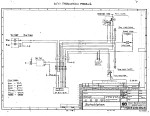
Puch Schaltplan Jun-77
The original 6-wire plans,
for US models, where the
ignition powers the horn.
external ignition ground
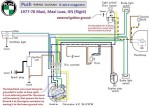
Puch 1977-78 (6-wire)
Maxi, Maxi Luxe, Rigid
Maxi 8709892-???????
Rigid 6830116-???????
6-wire Bosch magneto
1-speed 0212 124 043
external ignition ground
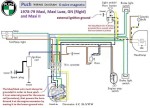
Puch 1978-79 (6-wire)
Maxi, Maxi II, Luxe, Rigid
6-wire Bosch magneto
1-speed 0212 124 043
2-speed 0212 124 044
external ignition ground
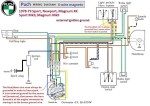
Puch 1978-79 (6-wire)
Sport, Newport, Magnum
Sport MkII, Magnum MkII
1-speed 0212 124 043
2-speed 0212 124 044
external ignition ground
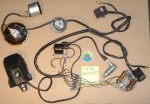
Puch 1978-79 (6-wire)
Sport, Newport, Magnum
Sport MkII, Magnum MkII
w/square black switches
CEV 2-bulb tail light
external ignition ground
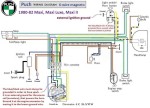
Puch 1980-82 (6-wire)
Maxi, Maxi II, Maxi Luxe
1-speed 0215 254 658
2-speed 0215 254 674
external ignition ground
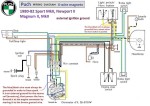
Puch 1980-82 (6-wire)
Sport MkII, Newport II,
Magnum II, MkII
2-speed 0215 254 674
external ignition ground
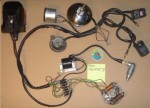
Puch 1980-82 (6-wire)
Sport MkII, Newport II
Magnum II, MkII
w/square black switches
external ignition ground
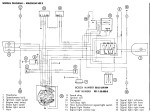
Puch 1980-82 (6-wire)
Magnum MkII, Limited Ed
with ignition key switch
2-speed 0215 254 674
external ignition ground
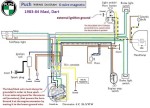
Puch 1983-84 (6-wire)
Maxi, Dart with
6VAC voltage regulator
1-speed 0215 254 658
external ignition ground

Puch 1983-84 (6-wire)
Maxi, Dart with
6VAC voltage regulator
original b & w diagram
external ignition ground
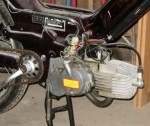
Puch 1984-86 (6-wire)
Maxi Sport LS, MS LS II
Cobra, Cobra II, ’85 Maxi
w/square black switches
external ignition ground
Puch Re-makes: After the last Austrian made Puch in 1986, three companies have reproduced the 1980’s Puch mopeds. Piaggio (Italy, early 90’s), Hero (India, late 90’s), and Manet (Hungary, late 90’s). While the most of engine is the same, the electrical equipment and wiring is different, more modern. All 1990’s and later mopeds have CDI ignitions with an internal ignition ground. Thanks to the advent of electronic solid state voltage regulation in the mid 1980’s, allowing stronger magneto/generators (50 or 80 watts instead of 30) without bulb burnout, modern mopeds don’t need to borrow “juice” from the ignition, so their ignition is separate from the lights or horn, and thus way more reliable.
